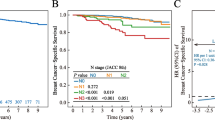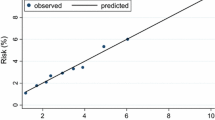Abstract
Invasive micropapillary carcinoma (IMPC) accounts for less than 2% of all invasive breast cancers and usually associates with poor survival, so we investigated the prognostic factors for IMPC using a large population-based database and designed a web-based novel model. Clinicopathological prognostic factors were evaluated using the Surveillance, Epidemiology, and End Results (SEER) database. Multivariate Cox regression analysis was performed to evaluate the prognostic value of variables on the overall survival. A web-based nomogram was finally constructed to predict the survival probability. The model was validated in an external dataset. A web-based model, combined with age, radiation, clinical stage, and hormone receptor (HR) immunochemistry status four prognostic factors, was constructed. The C-index (0.714, 95% CI 0.683–0.741), calibration curves, and decision curves showed that this model was superior in prediction. By determining the cut-off values, high-risk group and low-risk group were divided. The Kaplan–Meier survival curves showed that these two groups had significantly different survival rates (P < 0.0001). The result of C-index, calibration curves, and Kaplan–Meier survival curves were consistent in the validation cohort. The novel nomogram with four risk factors resulted in accurate prognostic prediction for IMPC.



Similar content being viewed by others
Data availability
The permission has been acquired for accessing to the SEER Research data. The datasets from SEER database presented in this study can be found online. The original contributions presented in this study are included in the article/supplementary material. Further inquiries can be directed to the corresponding authors.
References
Siegel RL, Miller KD, Wagle NS, Jemal A (2023) Cancer statistics, 2023. CA Cancer J Clin 73(1):17–48. https://doi.org/10.3322/caac.21763
Fu L, Ikuo M, Fu XY, Liu TH, Shinichi T (2004) Relationship between biologic behavior and morphologic features of invasive micropapillary carcinoma of the breast. Zhonghua Bing Li Xue Za Zhi 33(1):21–25
Luna-More S, Gonzalez B, Acedo C, Rodrigo I, Luna C (1994) Invasive micropapillary carcinoma of the breast. A new special type of invasive mammary carcinoma. Pathol Res Pract 190(7):668–674. https://doi.org/10.1016/S0344-0338(11)80745-4
Siriaunkgul S, Tavassoli FA (1993) Invasive micropapillary carcinoma of the breast. Mod Pathol 6(6):660–662
Luna-More S, de los Santos F, Breton JJ, Canadas MA (1996) Estrogen and progesterone receptors, c-erbB-2, p53, and Bcl-2 in thirty-three invasive micropapillary breast carcinomas. Pathol Res Pract 192(1):27–32. https://doi.org/10.1016/S0344-0338(96)80126-9
Middleton LP, Tressera F, Sobel ME et al (1999) Infiltrating micropapillary carcinoma of the breast. Mod Pathol 12(5):499–504
Paterakos M, Watkin WG, Edgerton SM, Moore DH 2nd, Thor AD (1999) Invasive micropapillary carcinoma of the breast: a prognostic study. Hum Pathol 30(12):1459–1463. https://doi.org/10.1016/s0046-8177(99)90168-5
Li W, Han Y, Wang C et al (2018) Precise pathologic diagnosis and individualized treatment improve the outcomes of invasive micropapillary carcinoma of the breast: a 12-year prospective clinical study. Mod Pathol 31(6):956–964. https://doi.org/10.1038/s41379-018-0024-8
Meng X, Ma H, Yin H et al (2021) Nomogram predicting the risk of locoregional recurrence after mastectomy for invasive micropapillary carcinoma of the breast. Clin Breast Cancer 21(4):e368–e376. https://doi.org/10.1016/j.clbc.2020.12.003
Yu JI, Choi DH, Huh SJ et al (2015) Differences in prognostic factors and failure patterns between invasive micropapillary carcinoma and carcinoma with micropapillary component versus invasive ductal carcinoma of the breast: retrospective multicenter case–control study (KROG 13-06). Clin Breast Cancer 15(5):353–361 e1–2. https://doi.org/10.1016/j.clbc.2015.01.008
Balachandran VP, Gonen M, Smith JJ, DeMatteo RP (2015) Nomograms in oncology: more than meets the eye. Lancet Oncol 16(4):e173–e180. https://doi.org/10.1016/S1470-2045(14)71116-7
Zhou YJ, Ye FZ, Li YY et al (2019) Individualized risk prediction of significant fibrosis in non-alcoholic fatty liver disease using a novel nomogram. Unit Eur Gastroenterol J 7(8):1124–1134. https://doi.org/10.1177/2050640619868352
Doll KM, Rademaker A, Sosa JA (2018) Practical guide to surgical data sets: surveillance, epidemiology, and end results (SEER) database. JAMA Surg 153(6):588–589. https://doi.org/10.1001/jamasurg.2018.0501
Pettinato G, Manivel CJ, Panico L, Sparano L, Petrella G (2004) Invasive micropapillary carcinoma of the breast: clinicopathologic study of 62 cases of a poorly recognized variant with highly aggressive behavior. Am J Clin Pathol 121(6):857–866. https://doi.org/10.1309/XTJ7-VHB4-9UD7-8X60
Walsh MM, Bleiweiss IJ (2001) Invasive micropapillary carcinoma of the breast: eighty cases of an underrecognized entity. Hum Pathol 32(6):583–589. https://doi.org/10.1053/hupa.2001.24988
Chen L, Fan Y, Lang RG et al (2008) Breast carcinoma with micropapillary features: clinicopathologic study and long-term follow-up of 100 cases. Int J Surg Pathol 16(2):155–163. https://doi.org/10.1177/1066896907307047
Yang YL, Liu BB, Zhang X, Fu L (2016) Invasive micropapillary carcinoma of the breast: an update. Arch Pathol Lab Med 140(8):799–805. https://doi.org/10.5858/arpa.2016-0040-RA
Lewis GD, Xing Y, Haque W et al (2019) Prognosis of lymphotropic invasive micropapillary breast carcinoma analyzed by using data from the National Cancer Database. Cancer Commun (Lond) 39(1):60. https://doi.org/10.1186/s40880-019-0406-4
Aker FV, Ekren E, Dogan M et al (2022) Clinicopathological features and prognosis of invasive micropapillary carcinoma compared to invasive ductal carcinoma-NOS: Worse or better? J Coll Physicians Surg Pak 32(9):1196–1201. https://doi.org/10.29271/jcpsp.2022.09.1196
Jiang C, Xiu Y, Qiao K et al (2022) Prediction of lymph node metastasis in patients with breast invasive micropapillary carcinoma based on machine learning and SHapley Additive exPlanations framework. Front Oncol 12:981059. https://doi.org/10.3389/fonc.2022.981059
Nassar H, Wallis T, Andea A et al (2001) Clinicopathologic analysis of invasive micropapillary differentiation in breast carcinoma. Mod Pathol 14(9):836–841. https://doi.org/10.1038/modpathol.3880399
De la Cruz C, Moriya T, Endoh M et al (2004) Invasive micropapillary carcinoma of the breast: clinicopathological and immunohistochemical study. Pathol Int 54(2):90–96. https://doi.org/10.1111/j.1440-1827.2004.01590.x
Zhao Y, Li S, Yan L et al (2022) Nomogram for predicting overall survival in patients with invasive micropapillary carcinoma after breast-conserving surgery: a population-based analysis. Front Surg 9:1009149. https://doi.org/10.3389/fsurg.2022.1009149
Wu SG, Zhang WW, Sun JY et al (2017) Postoperative radiotherapy for invasive micropapillary carcinoma of the breast: an analysis of surveillance, epidemiology, and end results database. Cancer Manag Res 9:453–459. https://doi.org/10.2147/CMAR.S141338
Osborne CK, Fisher E, Redmond C et al (1981) Estrogen receptor, a marker for human breast cancer differentiation and patient prognosis. Adv Exp Med Biol 138:377–385. https://doi.org/10.1007/978-1-4615-7192-6_23
Clark GM, Osborne CK, McGuire WL (1984) Correlations between estrogen receptor, progesterone receptor, and patient characteristics in human breast cancer. J Clin Oncol 2(10):1102–1109. https://doi.org/10.1200/JCO.1984.2.10.1102
Yu JI, Choi DH, Park W et al (2010) Differences in prognostic factors and patterns of failure between invasive micropapillary carcinoma and invasive ductal carcinoma of the breast: matched case-control study. Breast 19(3):231–237. https://doi.org/10.1016/j.breast.2010.01.020
Luna-More S, Casquero S, Perez-Mellado A et al (2000) Importance of estrogen receptors for the behavior of invasive micropapillary carcinoma of the breast. Review of 68 cases with follow-up of 54. Pathol Res Pract 196(1):35–39. https://doi.org/10.1016/S0344-0338(00)80019-9
Wu Y, Zhang N, Yang Q (2017) The prognosis of invasive micropapillary carcinoma compared with invasive ductal carcinoma in the breast: a meta-analysis. BMC Cancer 17(1):839. https://doi.org/10.1186/s12885-017-3855-7
Overgaard M, Hansen PS, Overgaard J et al (1997) Postoperative radiotherapy in high-risk premenopausal women with breast cancer who receive adjuvant chemotherapy. Danish Breast Cancer Cooperative Group 82b Trial. N Engl J Med 337(14):949–955. https://doi.org/10.1056/NEJM199710023371401
Fisher B, Anderson S, Bryant J et al (2002) Twenty-year follow-up of a randomized trial comparing total mastectomy, lumpectomy, and lumpectomy plus irradiation for the treatment of invasive breast cancer. N Engl J Med 347(16):1233–1241. https://doi.org/10.1056/NEJMoa022152
Li D, Zhong C, Cheng Y et al (2019) A competing nomogram to predict survival outcomes in invasive micropapillary breast cancer. J Cancer 10(27):6801–6812. https://doi.org/10.7150/jca.27955
Chen AC, Paulino AC, Schwartz MR et al (2014) Population-based comparison of prognostic factors in invasive micropapillary and invasive ductal carcinoma of the breast. Br J Cancer 111(3):619–622. https://doi.org/10.1038/bjc.2014.301
Funding
This work was supported by double training project of the First Affiliated Hospital of Wenzhou Medical University (Grant No. spy202114), Science and Technology Plan Project of Wenzhou (Grant No. Y20220867), and the National Student Innovation and Entrepreneurship Training Program (Grant No. 202110343009).
Author information
Authors and Affiliations
Contributions
EC collected clinicopathological information and editing the manuscript. YD was responsible for analyzing the data of patients with IMPC and writing the draft. YC made contributions in data statistics. YG and HG collected resources and did investigation. XH reviewed and edited the manuscript. XZ and QL designed the research and reviewed the article. All authors have read and approved the submit of the article.
Corresponding authors
Ethics declarations
Conflict of interest
All authors declare that they have no conflict of interest.
Ethical approval
This study was approved by the Institutional Ethics Committee of the First Affiliated Hospital of Wenzhou Medical University.
Additional information
Publisher's Note
Springer Nature remains neutral with regard to jurisdictional claims in published maps and institutional affiliations.
Supplementary Information
Below is the link to the electronic supplementary material.
Rights and permissions
Springer Nature or its licensor (e.g. a society or other partner) holds exclusive rights to this article under a publishing agreement with the author(s) or other rightsholder(s); author self-archiving of the accepted manuscript version of this article is solely governed by the terms of such publishing agreement and applicable law.
About this article
Cite this article
Chen, E., Du, Y., Chen, Y. et al. A web-based novel model for predicting prognostic value in patients with invasive micropapillary carcinoma in breast cancer: a real-world data retrospective cohort study. Updates Surg 75, 1997–2004 (2023). https://doi.org/10.1007/s13304-023-01530-7
Received:
Accepted:
Published:
Issue Date:
DOI: https://doi.org/10.1007/s13304-023-01530-7




